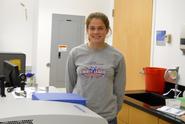
Fluorescent materials have important implications for modern technologies. However, the study of fluorescence can be a complex and precise matter. This summer, Erin Bessette-Kirton ’12, a physics major with minors in math and geology, will work with Professor of Physics Ann Silversmith to investigate the structure of terbium in doped sol-gel glass and the terbium concentration’s effect on fluorescence decay.
A material can be described as fluorescent if it absorbs light of a certain wavelength and emits light of a different wavelength. In UV lighting, florescent material emits light of a certain color and the fluorescence can be seen with the human eye. However, if the material undergoes fluorescence decay, meaning the intensity of fluorescence decreases, the color will appear to be dimmer.
For example, terbium, a rare earth ion, is a fluorescent element which appears purple or blue when exposed to UV light. There are certain crystals that can host terbium within their structures, such as YAG crystals. When YAG crystals contain terbium, they are referred to as “doped.” Depending on the concentration of terbium in the crystal, the severity of fluorescence decay differs. This is due to the phenomenon of cross-relaxation, in which samples with higher terbium concentrations fluoresce less. Cross-relaxation occurs because of an energy transfer between terbium ions which takes away from the amount of fluorescence that is emitted.
Physicists have already developed a model for how rare earth ion concentration relates to fluorescence decay in YAG crystals. Bessette-Kirton is working with doped sol-gel glass to see if fluorescence decay in the glass matches the model for decay in YAG crystals. Sol-gel glass is made through a solution-gelation process, which allows Bessette-Kirton to synthesize the material in the lab at a lower temperature than traditional glass. She explains that if her findings on terbium concentration and decay do not match the YAG crystal model, she will work to find out why.
Hamilton students have been studying this area for several years. Previous studies have shown that materials similar to sol-gel glass do not follow the model for YAG crystals, and Bessette-Kirton expects to observe similar results in her own experiments. By exploring fluorescence decay in doped sol-gel glass, she hopes to find how terbium is organized within the structure of the glass. Bessette-Kirton plans on continuing this project as her senior thesis, contributing to the work of earlier Hamilton students.
Bessette-Kirton’s work starts with background research about previous experiments in similar areas. She has read work by Hamilton students as well as resources off the Hill to gain a firm grasp on the topic. She synthesizes both the doped crystals and the sol-gel glass in the inorganic chemistry lab, and then runs spectroscopic analyses on her samples. These analyses show the intensity of fluorescence in the sample, and Bessette-Kirton uses her results from these tests to perform data analysis. Thus far, she has proved the model for YAG crystal fluorescence decay and terbium concentration and is currently performing similar tests on doped sol-gel glass.
Bessette-Kirton looks forward to learning more about fluorescence decay in sol-gel glass, as this type of research has applications in exciting technologies such as plasma-screen televisions. She particularly enjoys the process of synthesizing the crystals and glasses. Furthermore, Bessette-Kirton has done previous work in the chemistry labs, and so she is enjoying the opportunity to combine physics and chemistry. Outside the scientific realm, she plays field hockey for the Hamilton team, participates in Big Brothers Big Sisters and is a summer camp counselor.
Modern technologies could not advance without the dedicated efforts of physicists. Though the process of learning about fluorescence is long and intricate, the results can open new doors for scientific research.
Bessette-Kirton is a graduate of Arlington High School in Massachusetts.
Posted June 26, 2011
